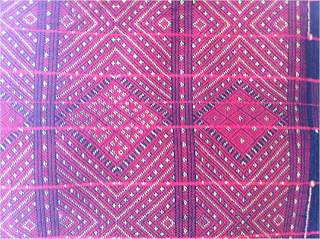 This tapis was found in an antique shop in Tanglin Shopping Centre, Singapore. It glimmers in the light because of the mirrorrs and metallic threads. Here, I use it as a table cloth.
This tapis was found in an antique shop in Tanglin Shopping Centre, Singapore. It glimmers in the light because of the mirrorrs and metallic threads. Here, I use it as a table cloth.
Tapis are elaborate skirts made in Lampung province, Sumatra, Indonesia. Women wore them with matching jackets during special events and ceremonies. Tapis were high-status ceremonial textiles that indicated the social rank of the wearer and her family. People also gave these skirts away as prestige gifts to indicate a family’s wealth and social standing. Tapis therefore were associated with power, status, and wealth.
 The more elaborate the skirt and those with the most gold-wrapped threads denoted the highest rank. Widows’ skirts, however, had limited decoration.
The more elaborate the skirt and those with the most gold-wrapped threads denoted the highest rank. Widows’ skirts, however, had limited decoration.
Traditional colours on tapis cloths include dark red, browns, indigo blue, dark green, ochre-yellow, and cream. The main decorative materials comprise horizontal, coloured stripes, gold- and silver wrapped threads, beads, pieces of felt and woven wool, and coloured yarns. The metal-wrapped threads, felt, wool, and coloured threads are couched (attached with stitches; 'cucuk') onto the surface of the cloth.
 The metal-wrapped threads are fastened to the fabric with threads sewn in a pattern, a decorative technique called 'sasab'. Sometimes the gold-wrapped threads were attached to paper-card before being couched onto the fabric. In addition to couching decorative materials to the cloth, the weavers also used brightly coloured yarns to embroider patterns onto the skirts. 'Cermuk' (pronounced chermuk) was the application of mirrors and mica to the tapis cloth. Since tapis are elaborate productions, making one could take up to a year.
The metal-wrapped threads are fastened to the fabric with threads sewn in a pattern, a decorative technique called 'sasab'. Sometimes the gold-wrapped threads were attached to paper-card before being couched onto the fabric. In addition to couching decorative materials to the cloth, the weavers also used brightly coloured yarns to embroider patterns onto the skirts. 'Cermuk' (pronounced chermuk) was the application of mirrors and mica to the tapis cloth. Since tapis are elaborate productions, making one could take up to a year.




















